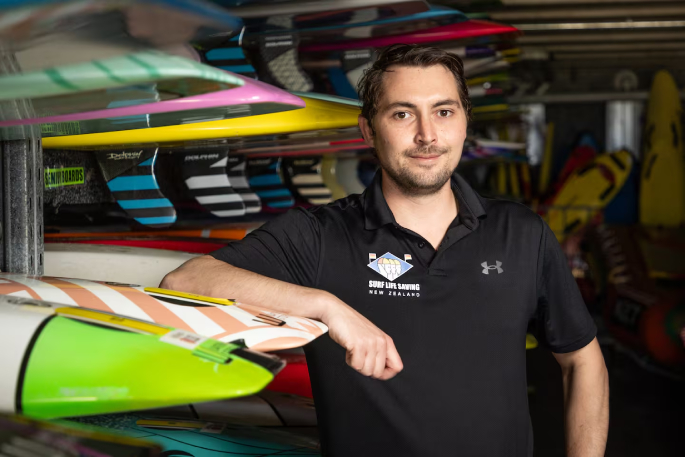Three people have drowned in the Bay of Plenty in seven months, data shows, as winter water enthusiasts are asked to be aware of the dangers of “cold water shock”.
The Water Safety New Zealand provisional drowning data showed the toll was four people at the same time last year.
A Water Safety NZ spokesperson says it did not provide details that would lead to the identification of those who had died but said the three provisional drowning deaths in the Bay this year were all male – one Māori and two European.
Two were aged between 35 and 44 and one between 45 and 54.
One drowning was at a beach, one in a river and one in an “offshore environment”.
Water-related deaths reported by police in the region this year include Tauranga man John Rawiri Piripi Pitihira, 37, who police say ran into the sea during a pursuit in April; and Rotorua man William Henry Genefaas, 39, who died after falling overboard near Whakaari/White Island last week.
Both cases were referred to the coroner, who would determine the cause and circumstances of the deaths.
Seventy-three people drowned in the Bay between 2014 and 2023, including five in 2023. They included Tauranga retiree Kerry Huggard in 2023 and Tauranga father Reon Wikeepa in 2022, both at Mount Maunganui Beach.
‘Drowning can almost always be prevented’
Surf Life Saving New Zealand eastern region lifesaving manager Chaz Gibbons-Campbell says last week’s World Drowning Prevention Day was an opportunity to be more mindful of the risks in and around the water.
“Far too many New Zealanders are drowning, and yet drowning can almost always be prevented.”
Chaz says surf lifesavers were backing Auckland’s “float first” campaign.
“The message is float first: knowing how to float can save lives. If you don’t know how to float, don’t go into the water.
“Every person who dies on our coastline is someone with a whānau and a community who loves them and misses them.
“During the months when our surf lifeguards are off duty, it’s crucial for all beachgoers to take precautions and be mindful of our other safety messages such as ‘if in doubt, stay out’.”
‘Unacceptable’ number of preventable deaths
Water Safety New Zealand chief executive Daniel Gerrard says the country was “still seeing an unacceptable number of preventable deaths”.
“Especially among older New Zealand males who continue to make risky choices around water.”
Daniel says it was important for all winter water enthusiasts to be aware of the dangers of “cold water shock”.
Cold water shock can lead to an immediate risk of drowning or cardiac arrest, he says.
The average winter temperature of New Zealand oceans is 15C and inland waters like lakes, rivers and waterfalls could be “much colder”.
“When plunged into cold water our first instinct is to gasp for air with an uncontrollable ‘gasp reflex’. Taking on one large breath of water is enough to prove fatal,” says Daniel.
“Our natural response is to swim hard and fight against the shock. This causes people to lose control of their movements and rapidly increases their heart rate. This lowers the chances of survival. All this happens in under two minutes.”
 Water Safety New Zealand chief executive Daniel Gerrard. Photo: Supplied.
Water Safety New Zealand chief executive Daniel Gerrard. Photo: Supplied.
Rather than panic, Daniel encourages eople who fall into the water to lie back, relax and float for the best chance of survival.
“The four key tips to remember are float, breathe, signal and survive.”
Water Safety NZ has provisionally recorded 38 drownings nationally between January 1 and June 30.
This was down from 53 drownings at the same time last year, which included six drownings due to Cyclone Gabrielle.
In the Bay of Plenty, ACC accepted 1851 water-related injury claims in 2023 at a cost of $9.5 million.
The winter activities with the highest claims were surfing (926), swimming (883), pool swimming (316) and boating (126).
Landmarks were lit up blue on July 25 to mark World Drowning Prevention Day, including the Bay Court Community and Arts Centre in Tauranga and the Civic buildings, Prince’s Gate and Clock Tower in Rotorua.
The same day, Rotorua fisherman William Henry Genefaas died after going overboard from a vessel near Whakaari/White Island.
The 39-year-old was reported missing in the early hours of July 25.
How to float first?
1. Float first – Lie back with your ears underwater, chin up.
2. Breathe normally – Slow your breathing to help you calm down.
3. Signal for help – Raise your arm. Shout for help.
4. Survive by swimming or floating – Float when it’s not safe to swim.
Water Safety Code:
1. Be prepared.
2. Look after yourself and others.
3. Be aware of the dangers.
4. Know your limits.
Boating Safety Code:
1. Wear your life jacket.
2. Take two waterproof ways to call for help.
3. Check the marine weather forecast.
4. Avoid alcohol.
5. Be a responsible skipper.



1 comment
Panic is a killer.
Posted on 06-08-2024 12:15 | By morepork
I can think of at least 4 occasions in my life where I probably would have died if I had given in to panic. Two of those incidents involved water. Fortunately, training and mental discipline got me through it. (And a modicum of luck in at least one of those incidents...) The fact that we are surrounded by water and yet many of our children can't swim is something we should be addressing. In my day, schools had swimming pools and we all strove to fill in the blank stickers on our swimming certificates. Starting with 5 yards and water skills, which involved overcoming fear of being underwater, then moving through progressive distances and, finally, a Life Saving sticker.
In the Army we learned drownproofing, complete with rifle, steel helmet and a 20 Kilo back pack. Drownproofing is for everyone. Check Google and learn it.
Leave a Comment
You must be logged in to make a comment.